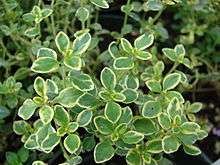Thymus citriodorus
| Thymus citriodorus | |
|---|---|
 | |
| Scientific classification | |
| Kingdom: | Plantae |
| (unranked): | Angiosperms |
| (unranked): | Eudicots |
| (unranked): | Asterids |
| Order: | Lamiales |
| Family: | Lamiaceae |
| Genus: | Thymus |
| Species: | T. citriodorus |
| Binomial name | |
| Thymus citriodorus (Pers.) Schreb. | |
| Synonyms | |
|
Thymus x citriodorus | |
Thymus citriodorus (Lemon thyme or Citrus thyme) is a lemon-scented evergreen mat-forming perennial. There has been a great deal of confusion over the plant's correct name and origin. Recent DNA analysis suggests that it is not a hybrid or cross, but a distinct species as it was first described in 1811.[1][2]
T. citriodorus is an evergreen sub-shrub, growing to 0.1 metres (3.9 in) in height by 0.3 metres (12 in) in spread. It prefers full sun and well draining soil. The bloom period is mid to late summer, with pink to lavender flowers that are a nectar source for bees and butterflies.[3]
Uses
Thymus citriodorus and its cultivars are cultivated as ornamental plants, culinary herbs, and medicinal plants. In gardens, the plants are often used as groundcovers: in planting beds, between stepping stones, and in containers. They are a drought tolerant plant when established.[4] As honey plants attracting wildlife, they are used in wildlife gardening.[3]
The leaves are used as a flavoring herb in cooking, raw in salads, and for a herbal teas.[3] Herbal medicinal uses can include the using leaves and/or essential oils in: antiseptics, asthma and respiratory aromatherapy, deodorants, and disinfectants.[3]
Taxonomy and synonyms
Thymus citriodorus has had many different names over time, including Thymus x citriodorus, Thymus fragrantissimus, Thymus serpyllum citratus, Thymus serpyllum citriodorum, and more. It was also believed at one time that the plant was a hybrid of European garden origin, between Thymus pulegioides and Thymus vulgaris. DNA analysis has shown that T. citriodorus is not part of the DNA tree that includes T. pulegioides and T. vulgaris.[2]
Cultivars
Cultivars are selected for foliage color, and aromas of different citrus fruits. The following are sold by various nurseries, often under the synonyms, so scientific naming is not reliable:
- Lemon Supreme[5] — Light mauve flowers on vigorous plants with much richer lemon scent than that of most lemon thymes.
- ‘Silver-Edged’ (Silver-Edged Lemon Thyme)[5] — Silver-edged green leaves; pink flowers.
- Creeping Golden Lemon[5] — Shiny dark green lemon-scented leaves variegated in gold; lavender flower spikes.
- Orange thyme[6] — orange, unusually low growing.
- Lime Thyme [5] — mounding ground cover with bright chartreuse green leaves, slightly to powerfully lime scented and flavored leaves, lavender-pink flowers.
References
- ↑ IPNI Listing
- 1 2 "Thymus citriodorus". Plant Heritage. 12 (2). Autumn 2005.
- 1 2 3 4 PFAF: taxonomy/treatment . accessed 12.1.2011
- ↑ High Country gardens: Low Water Plants . accessed 12.1.2011
- 1 2 3 4 Sunland Herbs
- ↑ Halcyon Plants: Thymus fragrantissimus 'Orange' - Orange thyme.
| Wikimedia Commons has media related to Thymus citriodorus. |
External links
- IPNI Listing
- Copy of Nature Heritage article explaining naming
- PFAF Plant Database treatment: Thymus x citriodorus (Lemon Thyme)